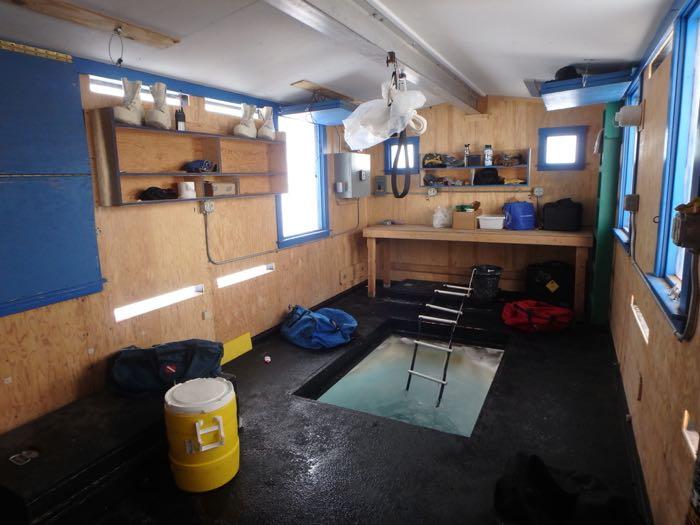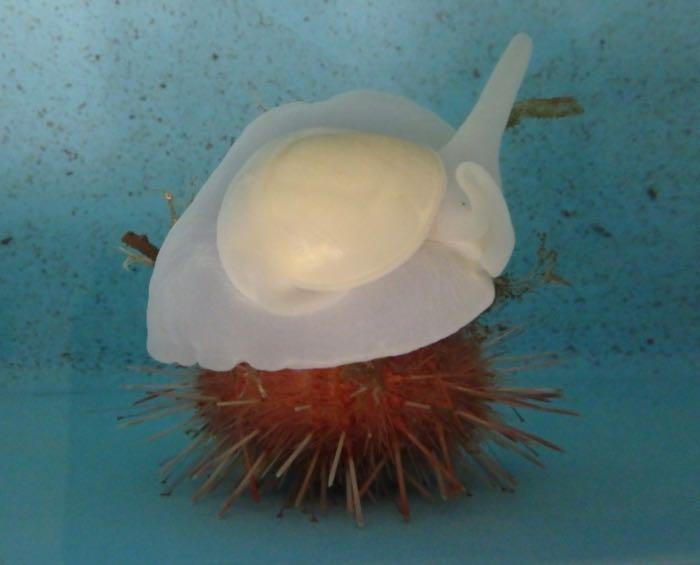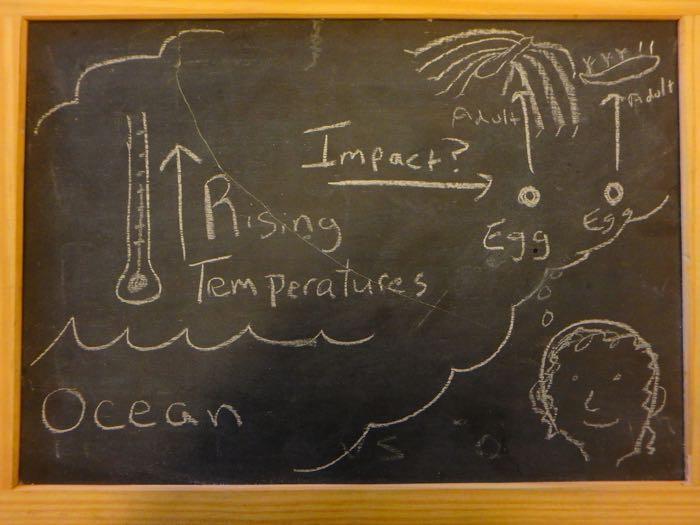"She blinded me with science" -Thomas Dolby
At 8:30am on Monday we loaded up the PistenBully for another adventure to Evans Wall. After the hour and a half journey over the bumpy snow covered sea ice we arrived at a familiar site, the dive hut at Evans Wall. As we opened the door we found the kuma stove wasn't working, the dive hole was covered with a thin layer of ice, and we were out of propane. This meant the next several hours would be cold ones, especially for the divers who wouldn't have a warm hut to return to after their search for spiders in the dark icy water.
 Icy dive hole inside the Evans Wall hut, McMurdo Sound, Antarctica. The divers did dive through this!
Icy dive hole inside the Evans Wall hut, McMurdo Sound, Antarctica. The divers did dive through this!
 The Kuma stove that is used for warmth and heating up food inside the dive huts. This one worked for about half of the time we were there on Monday. Fortunately, around lunch time on Tuesday more propane was delivered so we could use it! Evans Wall, McMurdo Sound, Antarctica
The Kuma stove that is used for warmth and heating up food inside the dive huts. This one worked for about half of the time we were there on Monday. Fortunately, around lunch time on Tuesday more propane was delivered so we could use it! Evans Wall, McMurdo Sound, Antarctica
We managed to eek a bit more life out of the stove, enough to last to heat some food and provide a warm space for the divers after their first 40 minute dive. As the divers pulled their dry suits back on for their second dive the stove fizzled out and the drafty space between the hole and the dive hut let in the chilly air. As we started to see our breath, the divers hopped back in for their second dive of the day.
 Inside the dive hut once the divers have all gone under the ice at Evans Wall, McMurdo Sound, Antarctica
Inside the dive hut once the divers have all gone under the ice at Evans Wall, McMurdo Sound, Antarctica
As a non-diving member of this team I wished I could figure out some way to heat that hut, some way to provide a warm space to the people who would soon come up with numb toes and fingers, ice hanging from beards, and frigid water to dump out of the necks of their suits. Instead, I spent my time hopping from foot to foot thinking of ways we could make the hut warmer and quizzing Graham about the research they are doing here. After all, that's what all of this is for, the hours and hours spent writing grants, the journey to Antarctica, the days spent diving in frigid water, the late nights and early mornings in the lab. This is where a question can lead you!!
 A view of McMurdo Station, Antarctica
A view of McMurdo Station, Antarctica
What are the effects, if there are any, of changing ocean temperatures on the metabolism, growth rate, developmental rate, and developmental energetics of embryos and larvae of Antarctic marine ectotherms?
For B-307, known around McMurdo as the spider team, this is the question that led Dr. Amy Moran and her team down here. So, let's break down this question into some parts.
First the facts you need to know:
Globally, the ocean temperature is increasing The rate of this increase is around 0.31°C (0.23°F) per year (epa.gov). These rising ocean temperatures include both the surface ocean and the deep ocean. This warming trend includes the ocean around Antarctica.
 As a whole the world, including the oceans, is getting warmer. Graph and data from NOAA National Centers for Environmental Information, State of the Climate: Global Climate Report for June 2019, published online July 2019, retrieved on November 6, 2019 from https://www.ncdc.noaa.gov/sotc/global/201906.
As a whole the world, including the oceans, is getting warmer. Graph and data from NOAA National Centers for Environmental Information, State of the Climate: Global Climate Report for June 2019, published online July 2019, retrieved on November 6, 2019 from https://www.ncdc.noaa.gov/sotc/global/201906.
Why is the ocean warming? The ocean is really great at absorbing heat. (You can look back at my journal titled "Who Cares About Sea Ice?" to fully understand why the ocean absorbs heat.) As the atmosphere continues to warm then the oceans will continue to warm.
Animals that call the frigid waters around Antarctica home live in a fairly constant and chilly -1.8°C (28.8°F) environment. This temperature changes less than 1°C throughout the year. Compare this to the Pacific Ocean along the California coast. In August and September the ocean near San Francisco averages around 15.5°C (60°F) and in the winter it averages 11.7°C (53°F). The ocean temperature in the bay area of California fluctuates around 4°C (7°F). Do you have a lake, ocean or other big body of water around you? If so, what is the difference in temperature between the warmer months and the colder months?
 This sea urchin and snail are both marine ectotherms. They are adapted to live in the -1.8°C waters of around Antarctica. Crary Lab, McMurdo Station, Antarctica
This sea urchin and snail are both marine ectotherms. They are adapted to live in the -1.8°C waters of around Antarctica. Crary Lab, McMurdo Station, Antarctica
Because of the cold temperatures, it takes marine ectotherms a very long time to develop. They often take about a year to fully develop. One species of sea snail takes 8 years to hatch!
Ok, so the oceans are warming and there are these animals called marine ectotherms that live in it. In Antarctica the animals that call the ocean home have a pretty stable environment temperature-wise and they are highly adapted to live in the very cold Antarctic waters. The development time of these animals can be quite long relative to other animals. So, the big question is, as the ocean temperatures continue to rise will the growth and development of these animals be impacted?
 Will the rising ocean temperatures impact the growth and development of marine ectotherms, specifically sea spiders and nudibranchs? If so, how?
Will the rising ocean temperatures impact the growth and development of marine ectotherms, specifically sea spiders and nudibranchs? If so, how?
To figure this out the research team needs to:
gather some eggs of marine ectotherms or gather the marine ectotherms and hope they lay eggs
expose these eggs to different temperatures, including the current ocean temperature (-1.8°C)
observe and note the development from egg to juvenile to adult. This includes noting impacts on metabolism, meaning the chemical processes that help living things live, and where and how the animals use their energy as they develop
The team will also measure the change in temperature and oxygen level in the ocean throughout the year AND compare metabolism of embryo and larvae in the winter to that in the summer.
 This nudibranch is currently laying an egg mass in the lab. I found this this morning during my daily observations of the animals. This is exciting because it means we can study these eggs. Crary Lab, McMurdo Station, Antarctica.
This nudibranch is currently laying an egg mass in the lab. I found this this morning during my daily observations of the animals. This is exciting because it means we can study these eggs. Crary Lab, McMurdo Station, Antarctica.
Whew! That's a lot!
Over the next few journal posts I'll dive into the specific experiments the researchers are running and what, if anything, they've found so far. I'll also cover the scientific instruments and tools they are using to help them.
In the meantime, think about what lives around you. What changes have you noticed? What living thing would you be interested in studying? How would you set up an experiment to see how temperature affects their growth and development? Write your answers to one or all of these questions below.
JOIN ME LIVE FROM MCMURDO STATION IN ANTARCTICA!
Want to talk to me live at McMurdo field station in Antarctica? Want to meet some of the animals that live in the aquarium here in Antarctica? Want to hear more about the research we are doing, see it in action, and ask questions? Then sign up for my PolarConnect event! This will be a 45 minute to 1 hour live presentation and conversation. All are welcome to join! It will be geared towards K-12 classrooms so be sure to tell your teacher friends, or if you are a teacher please join in!!!
When: November 22, 2019 8:30 AM AKST (9:30 AM PST, 10:30 AM MST, 11:30 AM CST, 12:30 PM EST)
How: You need to register for the event by clicking HERE. You'll need to select November 22 Amy Osborne under Event Choice.
I hope you can join me!!
Steve asked questions about sea spider hearts and blood and where all of the waste that McMurdo produces goes. Steve, we'll get to your heart and blood question tomorrow. As far as the waste at McMurdo, ideally, everyone sorts their waste properly into compost, landfill, and recycling. Once the ship can come again, which I believe happens once the sea ice has broken up sometime in February or March, it is shipped back to the United States, specifically to California. According to the McMurdo Station Guide, "the U.S. Antarctic program ships more than 300 shipping containers of waste back to the U.S. every year. More than 50% is recycled."
There's also something called Skua, named after a local scavenging bird, where you can donate used personal items or get, for free, used personal items. Think of it as one giant community clothing/other stuff swap. A lot of people created Halloween costumes using Skua and it's a great place to find clothes and room decorations.
 At the end of each hallway in the dorm there are cans labeled recycling, landfill, and food waste.Skua items go on the shelf under the window. Each week someone in the dorm is assigned to take these and dump them in the bins outside of the dorm. McMurdo Station, Antarctica
At the end of each hallway in the dorm there are cans labeled recycling, landfill, and food waste.Skua items go on the shelf under the window. Each week someone in the dorm is assigned to take these and dump them in the bins outside of the dorm. McMurdo Station, Antarctica
 Outside of each dorm are bins labeled landfill, recycling, food waste, and skua. These are picked up. The skua items go to a central skua location and the rest are stored for pick up once the ship comes in. McMurdo Station, Antarctica
Outside of each dorm are bins labeled landfill, recycling, food waste, and skua. These are picked up. The skua items go to a central skua location and the rest are stored for pick up once the ship comes in. McMurdo Station, Antarctica
As always feel free to ask me some questions or make comments on my posts in the comments section below. I love hearing from you all!


Comments
Add new comment